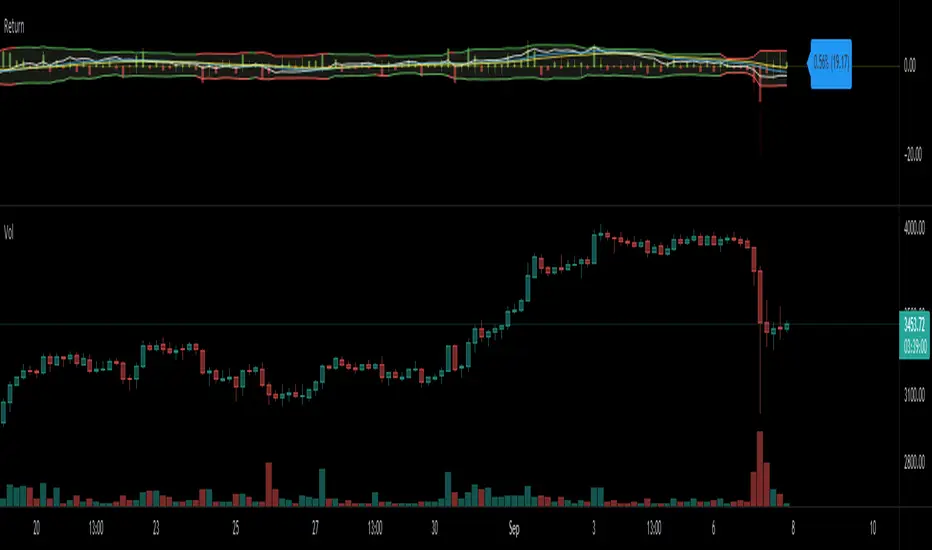OPEN-SOURCE SCRIPT
Aktualisiert Return (Percent Change)

This Script displays Regular or Log Returns as either a line or histogram and labels the current bar.
If something other than price is selected as the source, the result is percent change with a positive or negative slope.
If a moving average of price is used as the source, the result is analogous to a strength index
Other options include a look-back period adjustment (the default is 1),
smoothing results by converting to an EMA, and
Bollinger Bands with Length and Standard Deviation inputs.
If something other than price is selected as the source, the result is percent change with a positive or negative slope.
If a moving average of price is used as the source, the result is analogous to a strength index
Other options include a look-back period adjustment (the default is 1),
smoothing results by converting to an EMA, and
Bollinger Bands with Length and Standard Deviation inputs.
Versionshinweise
Name Shortened to "Return"Versionshinweise
precision increased to two decimal placesVersionshinweise
// This Script displays Regular or Log Returns as either a line or histogram and labels the current bar. // Additionally, an "ArcTan" method is available which allows the slope of a line that crosses zero to be displayed.
// If a moving average of price is used as the source, the result is analogous to a strength index
// Other options include smoothing by converting to an EMA of returns,
// Bollinger Bands with SMA for the Length, and Standard Deviation for the Width.
// When the BB Basis is positive the bands appear green, and when negative they are red.
// if you set the BB basis to one, the color of the BB histogram will indicate the slope only.
Versionshinweise
Two Decimal Places for Absolute Change LabelVersionshinweise
corrected log input type spellingVersionshinweise
...Versionshinweise
Option to display absolute values was added.Bollinger Bands can be toggled on/off.
Versionshinweise
Script has been updated to allow Return and Basis to be expressed as several different types of moving average. From the Pinescript Reference:sma: The sma function returns the moving average, that is the sum of last y values of x, divided by y.
ema: The ema function returns the exponentially weighted moving average. In ema weighting factors decrease exponentially. It calculates by using a formula: EMA = alpha * x + (1 - alpha) * EMA[1], where alpha = 2 / (y + 1)
wma: The wma function returns weighted moving average of x for y bars back. In wma weighting factors decrease in arithmetical progression.
rma: Moving average used in RSI. It is the exponentially weighted moving average with alpha = 1 / length.
swma: Symmetrically weighted moving average with fixed length: 4. Weights: [1/6, 2/6, 2/6, 1/6].
vwma: The vwma function returns volume-weighted moving average of x for y bars back. It is the same as: sma(x * volume, y) / sma(volume, y)
Bands may be displayed as:
std dev: Standard Deviation (typical multiple value=2)
atr: Average True Range (typical multiple value = 1) RMA of true range. True range is max(high - low, abs(high - close[1]), abs(low - close[1]))
Here's an example show Bi-Weekly Log Returns of the entire history of bitcoin:
Here's an example of Daily Reg Returns in Absolute Price and the indicator being used to show the 30SMA Slope:
Versionshinweise
Added functionality to magnify basis line (display only)Versionshinweise
corrected idea imageVersionshinweise
formattingVersionshinweise
corrected versioningVersionshinweise
formattingVersionshinweise
Script has been updated to include wicks, so you can now see candles normalized to zero.Two EMA's of the basis also have been added as an option, as well as the ability to magnify the plots (display only).
Open-source Skript
Ganz im Sinne von TradingView hat dieser Autor sein/ihr Script als Open-Source veröffentlicht. Auf diese Weise können nun auch andere Trader das Script rezensieren und die Funktionalität überprüfen. Vielen Dank an den Autor! Sie können das Script kostenlos verwenden, aber eine Wiederveröffentlichung des Codes unterliegt unseren Hausregeln.
Haftungsausschluss
Die Informationen und Veröffentlichungen sind nicht als Finanz-, Anlage-, Handels- oder andere Arten von Ratschlägen oder Empfehlungen gedacht, die von TradingView bereitgestellt oder gebilligt werden, und stellen diese nicht dar. Lesen Sie mehr in den Nutzungsbedingungen.
Open-source Skript
Ganz im Sinne von TradingView hat dieser Autor sein/ihr Script als Open-Source veröffentlicht. Auf diese Weise können nun auch andere Trader das Script rezensieren und die Funktionalität überprüfen. Vielen Dank an den Autor! Sie können das Script kostenlos verwenden, aber eine Wiederveröffentlichung des Codes unterliegt unseren Hausregeln.
Haftungsausschluss
Die Informationen und Veröffentlichungen sind nicht als Finanz-, Anlage-, Handels- oder andere Arten von Ratschlägen oder Empfehlungen gedacht, die von TradingView bereitgestellt oder gebilligt werden, und stellen diese nicht dar. Lesen Sie mehr in den Nutzungsbedingungen.